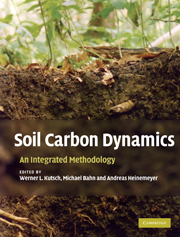Book contents
- Frontmatter
- Contents
- List of Contributors
- Preface
- Editorial Acknowledgements
- 1 Soil carbon relations: an overview
- 2 Field measurements of soil respiration: principles and constraints, potentials and limitations of different methods
- 3 Experimental design: scaling up in time and space, and its statistical considerations
- 4 Determination of soil carbon stocks and changes
- 5 Litter decomposition: concepts, methods and future perspectives
- 6 Characterization of soil organic matter
- 7 Respiration from roots and the mycorrhizosphere
- 8 Separating autotrophic and heterotrophic components of soil respiration: lessons learned from trenching and related root-exclusion experiments
- 9 Measuring soil microbial parameters relevant for soil carbon fluxes
- 10 Trophic interactions and their implications for soil carbon fluxes
- 11 Semi-empirical modelling of the response of soil respiration to environmental factors in laboratory and field conditions
- 12 Modelling soil carbon dynamics
- 13 The role of soils in the Kyoto Protocol
- 14 Synthesis: emerging issues and challenges for an integrated understanding of soil carbon fluxes
- 15 Appendix: Towards a standardized protocol for the measurement of soil CO2 efflux
- Index
- References
13 - The role of soils in the Kyoto Protocol
Published online by Cambridge University Press: 11 May 2010
- Frontmatter
- Contents
- List of Contributors
- Preface
- Editorial Acknowledgements
- 1 Soil carbon relations: an overview
- 2 Field measurements of soil respiration: principles and constraints, potentials and limitations of different methods
- 3 Experimental design: scaling up in time and space, and its statistical considerations
- 4 Determination of soil carbon stocks and changes
- 5 Litter decomposition: concepts, methods and future perspectives
- 6 Characterization of soil organic matter
- 7 Respiration from roots and the mycorrhizosphere
- 8 Separating autotrophic and heterotrophic components of soil respiration: lessons learned from trenching and related root-exclusion experiments
- 9 Measuring soil microbial parameters relevant for soil carbon fluxes
- 10 Trophic interactions and their implications for soil carbon fluxes
- 11 Semi-empirical modelling of the response of soil respiration to environmental factors in laboratory and field conditions
- 12 Modelling soil carbon dynamics
- 13 The role of soils in the Kyoto Protocol
- 14 Synthesis: emerging issues and challenges for an integrated understanding of soil carbon fluxes
- 15 Appendix: Towards a standardized protocol for the measurement of soil CO2 efflux
- Index
- References
Summary
INTRODUCTION
The world's soils contain approximately 1500 Pg (1 Pg = 1 Gt = 1015 g) of organic carbon (Batjes, 1996), roughly three times the amount of carbon in vegetation and twice the amount in the atmosphere (IPCC, 2001; Denman et al., 2007). The annual fluxes of CO2 from atmosphere to land (global net primary productivity, NPP) and land to atmosphere (respiration and fire) are of the order of 60 Pg C y−1 (IPCC, 2000b). During the 1990s, fossil fuel combustion and cement production emitted 6.4 ± 1.3 Pg C y−1 to the atmosphere, while land-use change emitted 1.6 ± 0.8 Pg C y−1. Atmospheric carbon increased at a rate of 3.2 ± 0.1 Pg C y−1, the oceans absorbed 2.3 ± 0.8 Pg C y−1 and there was an estimated terrestrial sink of 2.6 ± 1.3 Pg C y−1 (Schimel et al., 2001; Denman et al., 2007). The amount of carbon stored in soils globally is therefore large compared to gross and net annual fluxes of carbon to and from the terrestrial biosphere, and the pools of carbon in the atmosphere and vegetation. Because of this, increasing the size of the global soil carbon pool by even a small proportion has the potential to sequester large amounts of carbon, and thus soils have an important role to play in mitigating climate change.
Human intervention, via cultivation and disturbance, has decreased and still is decreasing the soil carbon pools relative to the store typically achieved under native vegetation.
- Type
- Chapter
- Information
- Soil Carbon DynamicsAn Integrated Methodology, pp. 245 - 256Publisher: Cambridge University PressPrint publication year: 2010
References
- 1
- Cited by

